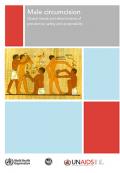Publications - Released in 2007
Male circumcision is one of the oldest and most common surgical procedures worldwide, and is undertaken for many reasons: religious, cultural, social and medical. There is conclusive evidence from observational data and three randomized controlled trials that circumcised men have a significantly lower risk of becoming infected with the human immunodeficiency virus (HIV). Demand for safe, affordable male circumcision is expected to increase rapidly, and country-level decision-makers need information about the sociocultural and medical determinants of circumcision, as well as risks of the procedure, in the context of comprehensive HIV prevention programming.
The aim of this report is to review the determinants, prevalence, safety and acceptability of male circumcision, focusing on sub-Saharan Africa.
Downloads
Organizations
- World Health Organization (WHO)
- Joint United Nations Programme on HIV/AIDS (UNAIDS)






